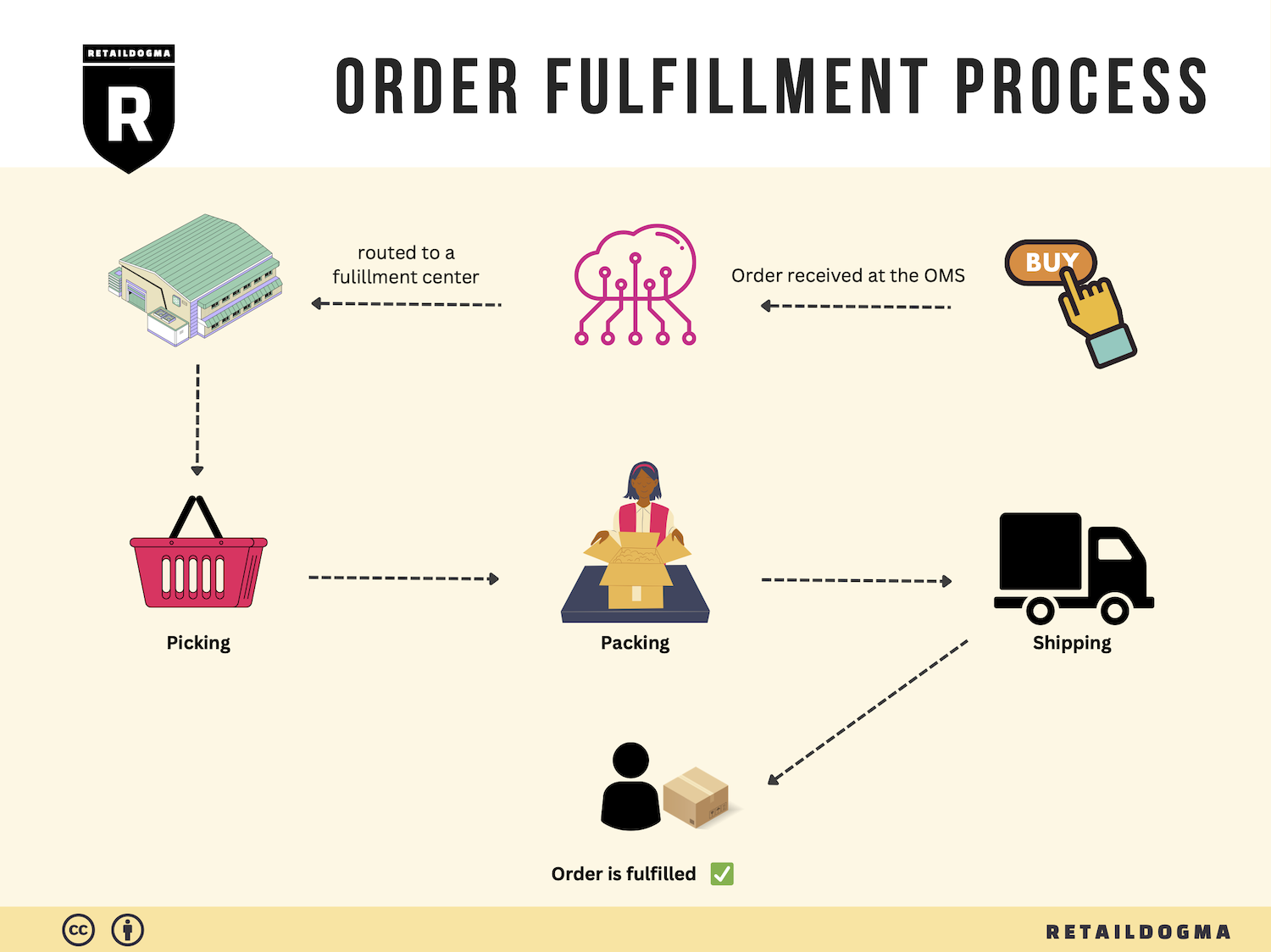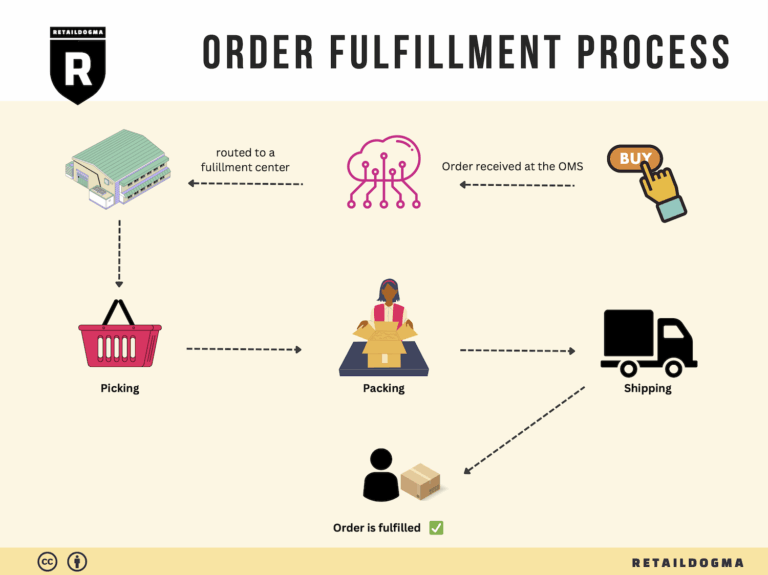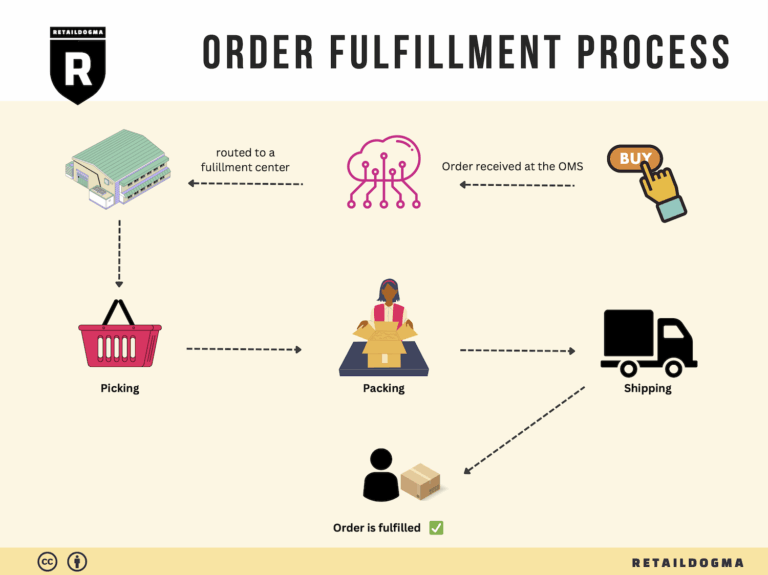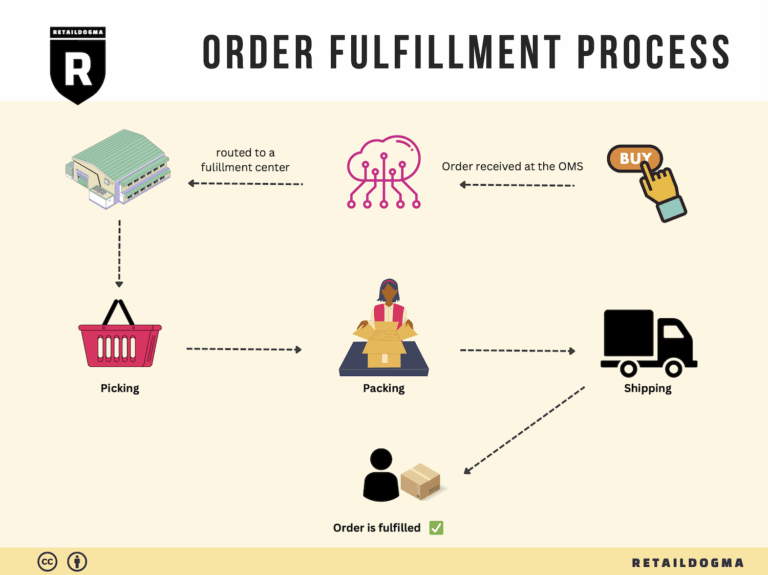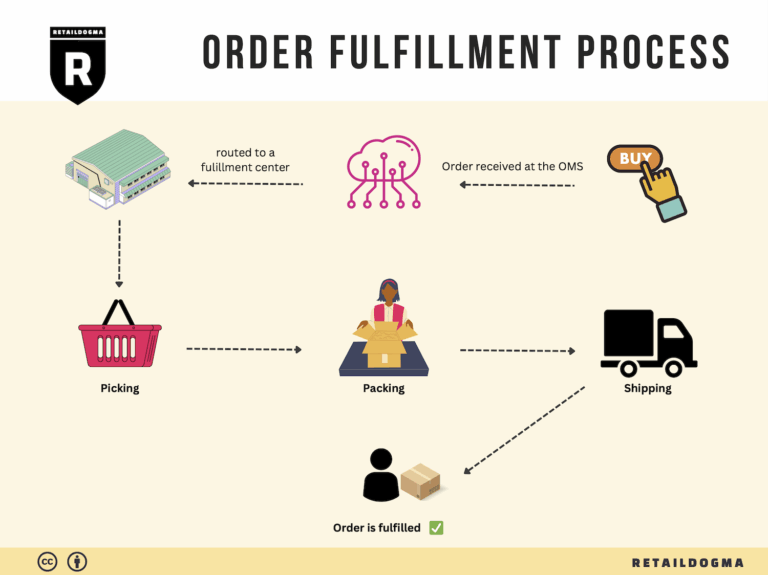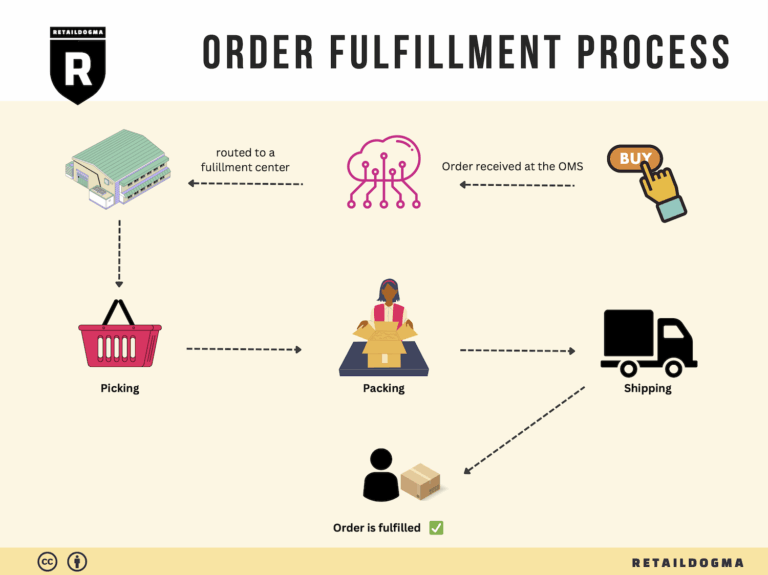How Order Fulfillment Works: A Step-by-Step Guide for Businesses
What is E-commerce Fulfillment? An Introduction for Growing Businesses
Understanding the Challenges of E-commerce Fulfillment
As an e-commerce business owner, you may find yourself overwhelmed by the complexities of packing and shipping orders. This common pain point can stifle your growth and distract you from focusing on what truly matters: scaling your sales and enhancing customer satisfaction. The fulfillment process—essentially, the journey of getting a product from your warehouse to your customer’s doorstep—can become a daunting task if not managed effectively.
Defining E-commerce Fulfillment
E-commerce fulfillment encompasses all the steps necessary to deliver a product to a customer after they make a purchase. This includes receiving inventory, storing it, picking and packing orders, shipping them out, and managing returns. As your business grows, the intricacies of fulfillment can multiply, leading to potential pitfalls like delayed shipments, inventory inaccuracies, and ultimately, dissatisfied customers.
What This Guide Will Cover
In this guide, we will explore various fulfillment models that can help streamline your operations. You’ll learn about:
-
Third-Party Logistics (3PL): Outsourcing your fulfillment processes to specialized providers who can handle storage, packing, and shipping on your behalf.
-
Fulfillment by Amazon (FBA): Leveraging Amazon’s vast network of fulfillment centers, including the IND9 facility in Greenwood, IN, which specializes in fast and efficient order processing.
We will also cover the core services typically offered by fulfillment partners, such as inventory management, order tracking, and returns handling. Choosing the right fulfillment partner is crucial; therefore, we will provide insights on what to look for in a logistics partner, including their technology capabilities, service levels, and customer support.
Additionally, pricing models will be discussed to help you understand the costs associated with different fulfillment options, allowing you to make informed decisions that align with your budget and operational needs.
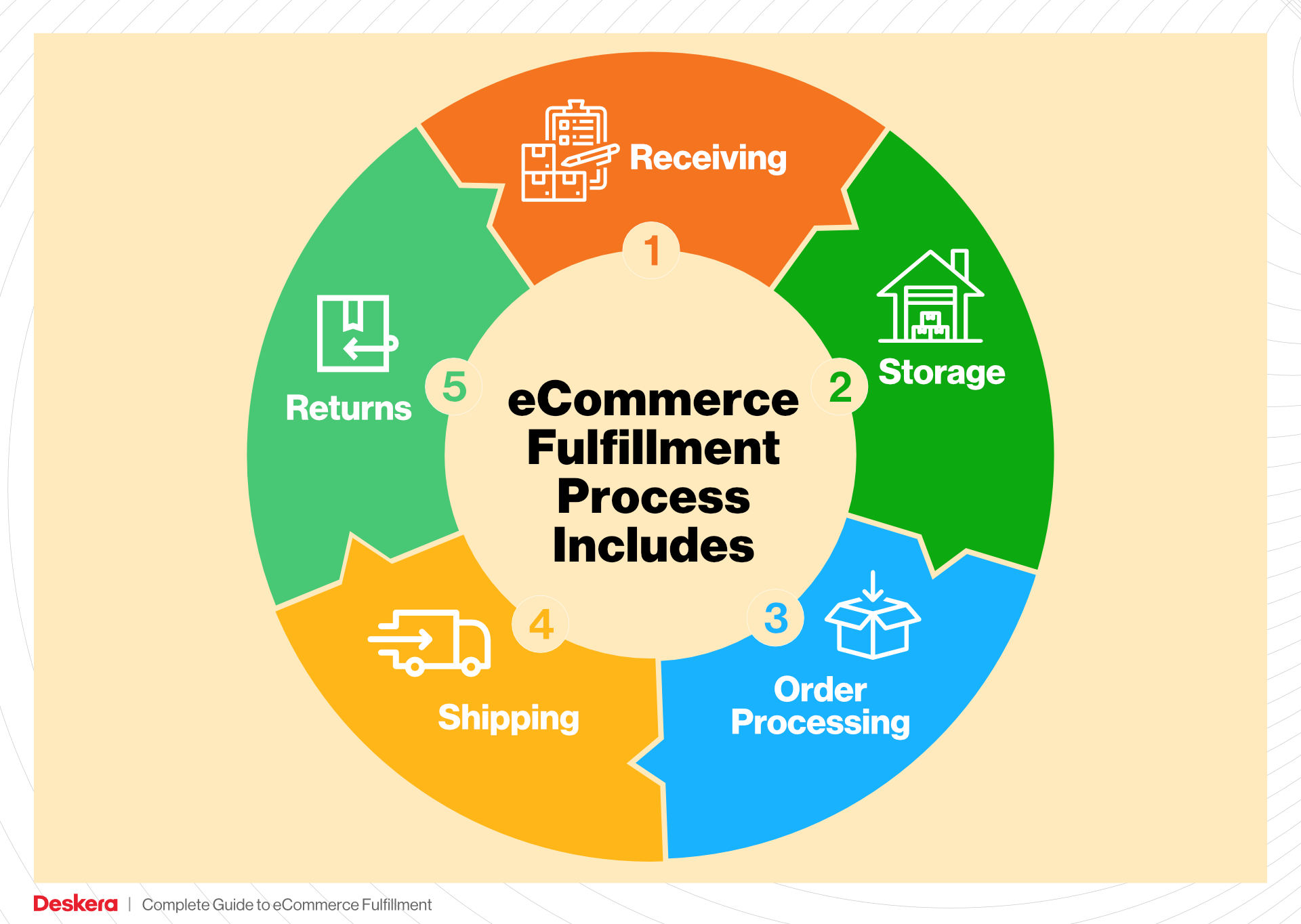
Empowering Your Business Decisions
The ultimate goal of this guide is to empower you with the knowledge and tools necessary to make smart decisions about your logistics strategy. By understanding the various aspects of e-commerce fulfillment, you can optimize your operations, enhance customer satisfaction, and create a scalable business model that supports your growth ambitions. Whether you’re just starting or looking to refine your existing fulfillment processes, this guide will serve as a valuable resource for navigating the complexities of e-commerce fulfillment.
What You’ll Learn In This Guide
- What is E-commerce Fulfillment? An Introduction for Growing Businesses
- The Order Fulfillment Process: From ‘Buy’ Button to Customer’s Door
- Comparing Fulfillment Models: In-House vs. 3PL vs. Dropshipping
- A Deep Dive into Amazon FBA: Pros, Cons, and Who It’s For
- Core Services Offered by Fulfillment Centers
- How to Choose a Fulfillment Partner: A 6-Point Checklist
- Understanding Fulfillment Pricing: A Breakdown of Common Fees
- Frequently Asked Questions (FAQs) about Fulfillment
- Conclusion: Is Outsourcing Fulfillment the Right Move for Your Business?
- Important Disclaimer
The Order Fulfillment Process: From ‘Buy’ Button to Customer’s Door
1. Receiving Inventory
The first step in the order fulfillment process is receiving inventory. When products arrive at the Amazon Fulfillment Center-IND9, they undergo a thorough inspection to ensure quality and accuracy. Each item is assigned a Stock Keeping Unit (SKU), a unique identifier that helps track inventory levels and product details throughout the supply chain.
This step is crucial because it sets the foundation for efficient inventory management. Properly received inventory reduces errors and ensures that the right products are available when orders come in. Accurate inventory data is vital for forecasting demand and managing stock levels, thus preventing stockouts or overstock situations.
2. Warehouse Storage
Once the inventory is received and inspected, it moves to the storage area of the fulfillment center. Here, products are organized based on their SKU numbers and stored in designated locations, often using automated systems for optimal space utilization. In the case of IND9, this includes advanced robotics that assist in managing the storage and retrieval of items.
Efficient warehouse storage is essential for minimizing retrieval time during order picking. By strategically organizing products, businesses can reduce the time employees or robots spend locating items. This not only enhances overall efficiency but also significantly improves the speed at which orders can be processed.
3. Order Picking
Order picking is the process of selecting the right products from the warehouse to fulfill customer orders. In a high-tech environment like Amazon’s IND9, this often involves using pick lists generated by the fulfillment management system. These lists guide workers or robots to the exact location of the items needed for each order.
This step is critical because the accuracy of order picking directly impacts customer satisfaction. Errors in picking can lead to incorrect shipments, resulting in returns and dissatisfied customers. Moreover, using technology to streamline this process enhances speed and reduces labor costs, allowing businesses to scale efficiently.
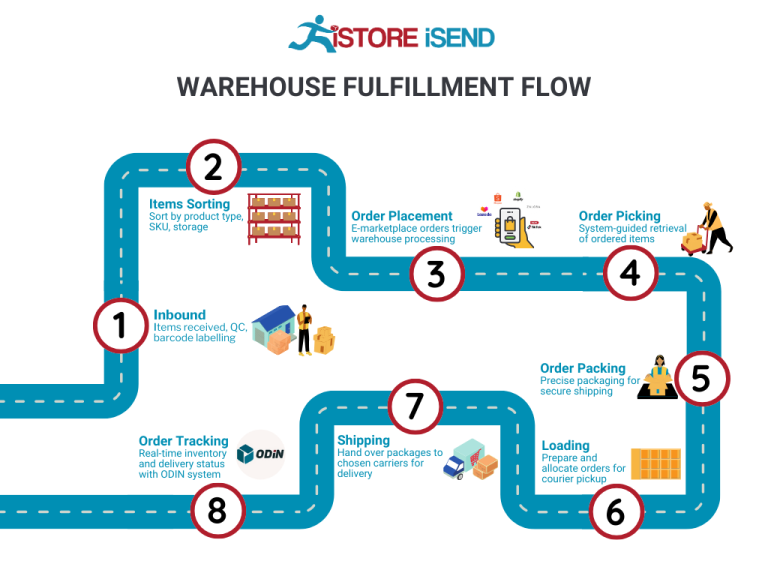
4. Order Packing
After items are picked, they proceed to the packing stage. Here, products are carefully packed into boxes or envelopes, often using automated packing machines to speed up the process. Packaging materials are selected based on the type of product and shipping requirements, ensuring that items are protected during transit.
Packing is a vital step because it ensures that products arrive at customers’ doors in excellent condition. Proper packing reduces the likelihood of damage during shipping, which can lead to costly returns and replacements. Additionally, effective packing can optimize shipping costs by minimizing dimensional weight, a key consideration for e-commerce businesses looking to maximize profit margins.
5. Shipping & Delivery
The final step in the order fulfillment process is shipping and delivery. Once packed, orders are labeled and sorted for delivery based on their destination. At IND9, advanced logistics systems are employed to manage these shipments efficiently, ensuring timely delivery to customers across the greater Indianapolis area and beyond.
Shipping and delivery are critical because they represent the culmination of the entire fulfillment process. A swift and reliable delivery service enhances customer satisfaction and builds brand loyalty. In today’s competitive e-commerce landscape, meeting or exceeding customer expectations for delivery speed can significantly influence purchasing decisions. Businesses must also consider the integration of tracking systems to keep customers informed about their order status, thereby improving the overall shopping experience.
In conclusion, mastering the order fulfillment process is essential for e-commerce business owners and operations managers aiming to scale their logistics efficiently. Each step—from receiving inventory to shipping and delivery—plays a vital role in ensuring customer satisfaction and operational effectiveness. Understanding and optimizing these steps can lead to improved performance and profitability in the competitive world of e-commerce.
Comparing Fulfillment Models: In-House vs. 3PL vs. Dropshipping
Comparison of Fulfillment Models
| Model | Who Handles Inventory | Best For (Business Stage) | Key Advantage | Key Disadvantage |
|---|---|---|---|---|
| In-House Fulfillment | The business itself | Established businesses | Full control over inventory and processes | High overhead costs and resource demands |
| Third-Party Logistics (3PL) | Third-party providers | Scaling businesses | Cost efficiency and scalability | Less control over the fulfillment process |
| Dropshipping | Supplier or manufacturer | Startups and small businesses | Low upfront investment and risk | Longer shipping times and lower margins |
In-House Fulfillment
In-house fulfillment refers to a model where a business manages its entire inventory and logistics operations internally. This approach is typically adopted by established businesses with sufficient resources and a steady order volume. By handling fulfillment in-house, companies maintain complete control over their inventory, order processing, and shipping, which can enhance quality assurance and customer satisfaction. Businesses can customize their fulfillment processes to align with their brand values and customer expectations, offering a unique experience that third-party providers may not replicate. However, this model comes with high overhead costs, including warehousing, staffing, and technology investments. Additionally, as order volume fluctuates, maintaining an in-house operation can become resource-intensive, requiring businesses to balance efficiency with scalability.
Third-Party Logistics (3PL)
Third-party logistics (3PL) providers offer a flexible solution for businesses looking to scale without the burden of managing logistics themselves. In this model, a business partners with a logistics provider that handles warehousing, inventory management, order processing, and shipping. This is particularly beneficial for growing companies that want to focus on core business activities such as product development and marketing, while outsourcing the complexities of fulfillment. 3PL providers can leverage economies of scale, often resulting in cost savings and improved shipping rates. They also bring expertise in logistics, which can enhance operational efficiency. However, businesses may face challenges related to diminished control over the fulfillment process, which can impact customer experience if not managed properly. It’s crucial for businesses to choose a reliable 3PL partner to ensure alignment with their service standards.
Dropshipping
Dropshipping is a fulfillment model where the retailer does not hold any inventory but instead relies on suppliers or manufacturers to fulfill customer orders. This model is particularly attractive for startups and small businesses due to its low upfront investment and minimal risk. Retailers can offer a wide range of products without the need for warehousing, as they only purchase items from suppliers after a sale has been made. This flexibility allows businesses to test new products and markets without significant financial commitment. However, dropshipping has its drawbacks. Shipping times can be longer since products are often sourced from various suppliers, which can lead to customer dissatisfaction. Additionally, profit margins tend to be lower compared to other fulfillment models, as retailers have less control over pricing and inventory management. For businesses considering dropshipping, it’s essential to establish strong relationships with reliable suppliers to mitigate risks and ensure a smooth fulfillment process.
In summary, each fulfillment model presents unique advantages and challenges tailored to different business needs and stages. In-house fulfillment offers control but requires substantial investment, while 3PL provides efficiency and scalability but at the cost of some control. Dropshipping stands out for its low entry barrier but comes with potential downsides related to shipping and margins. Understanding these differences allows e-commerce business owners to make informed decisions that align with their growth strategies and operational capabilities.
A Deep Dive into Amazon FBA: Pros, Cons, and Who It’s For
Understanding Fulfillment by Amazon (FBA)
Fulfillment by Amazon (FBA) is a service offered by Amazon that allows sellers to store their products in Amazon’s fulfillment centers. Amazon takes care of storage, packaging, shipping, and customer service for these products. This system is designed to simplify logistics for e-commerce businesses, enabling them to leverage Amazon’s extensive distribution network and customer service capabilities.
When a customer orders a product through Amazon, the FBA process kicks in. Amazon picks, packs, and ships the product directly to the customer, handling all aspects of the transaction, including returns and customer inquiries. This allows sellers to focus on growing their business while Amazon manages the logistics.
How FBA Works
-
Setting Up: Sellers create an Amazon seller account and enroll their products in FBA. They then ship their inventory to Amazon’s fulfillment centers.
-
Storage: Amazon stores the seller’s products in their warehouses. The seller is charged a monthly storage fee based on the amount of space their products occupy.
-
Order Processing: When a customer places an order, Amazon’s system automatically processes it. The product is picked from the shelf, packed, and shipped to the customer.
-
Customer Service: Amazon handles all customer inquiries and returns, providing a seamless experience for buyers.
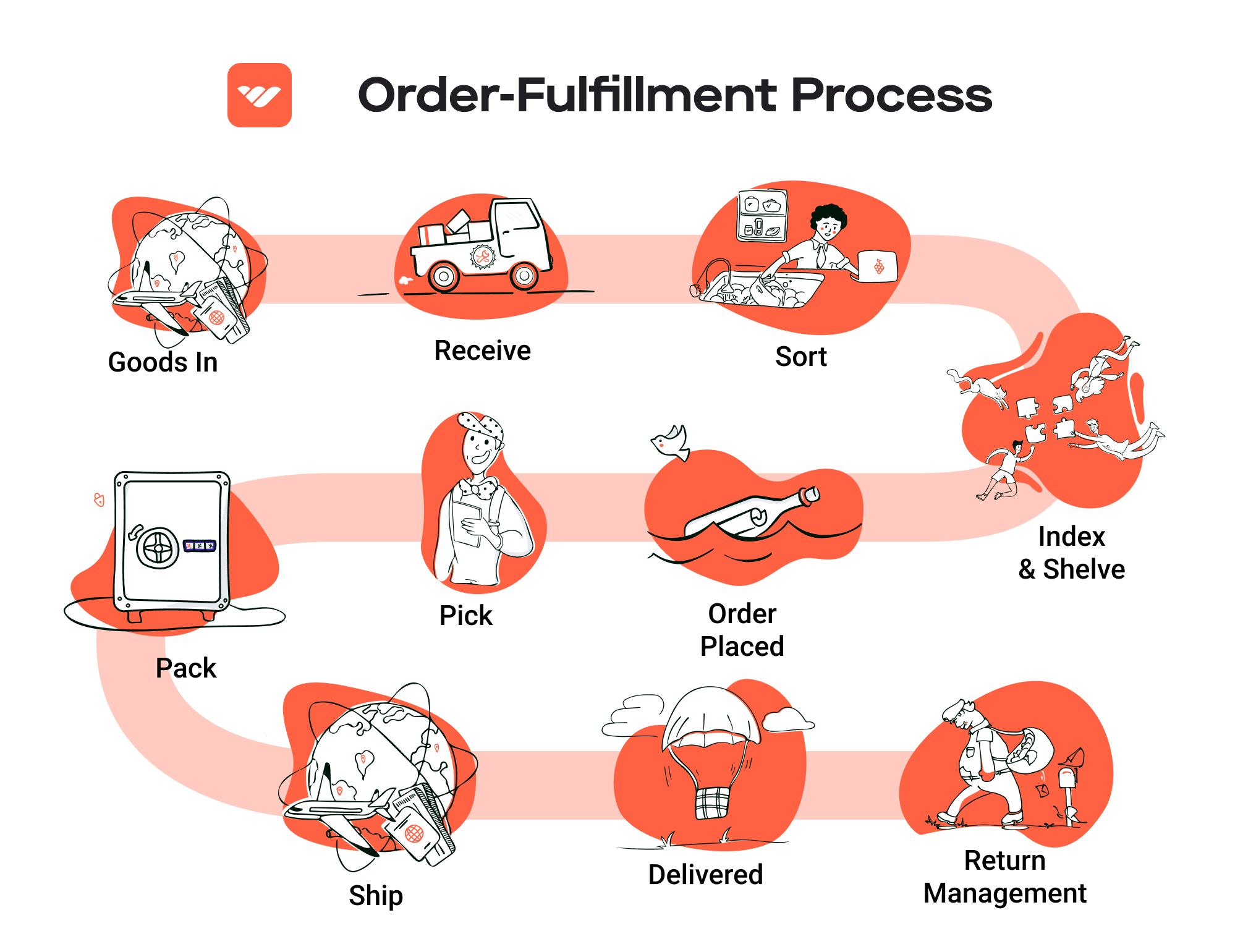
-
Payment: After the sale, the seller receives payment minus Amazon’s fees, which include referral and fulfillment fees.
Pros of Using FBA
Prime Eligibility
One of the most significant advantages of FBA is that products become eligible for Amazon Prime, which can significantly increase sales. Prime members often prefer products that are eligible for fast, free shipping. This added visibility can lead to higher conversion rates.
Customer Trust
Amazon is a well-established and trusted brand. By using FBA, sellers can leverage Amazon’s reputation, which can enhance customer trust in their products. Customers are more likely to buy from sellers who use FBA due to the assurance of reliable shipping and customer service.
Multi-Channel Fulfillment
FBA is not limited to Amazon sales. Sellers can also use FBA to fulfill orders from other sales channels, such as their own websites or other e-commerce platforms. This flexibility allows businesses to streamline their logistics while still maintaining control over their brand and customer relationships.
Scalability
FBA allows sellers to scale their businesses without the complexities associated with logistics and warehousing. As demand grows, sellers can easily send more inventory to Amazon without needing to invest in their own storage or fulfillment capabilities.
Streamlined Logistics
With Amazon managing storage, packing, and shipping, sellers can focus on other aspects of their business, such as marketing and product development. This can lead to improved efficiency and productivity.
Cons of Using FBA
High Fees
While FBA offers many benefits, it comes at a cost. Sellers must pay various fees, including monthly storage fees and per-unit fulfillment fees. These costs can add up quickly, especially for low-margin products, and may eat into profits.
Strict Inventory Rules
Amazon has strict guidelines regarding inventory management. Sellers must ensure that their inventory levels are adequate to meet demand, as running out of stock can negatively impact sales rankings. Additionally, Amazon may charge long-term storage fees for items that do not sell within a specific timeframe.
Commingling Risks
FBA has a commingling inventory policy, meaning that products from multiple sellers can be stored together. This can lead to complications if a customer receives a product that does not match the seller’s quality standards. If issues arise, it can be challenging for sellers to manage their reputation.
Limited Control Over Fulfillment
While Amazon handles the logistics, sellers have limited control over how their products are packaged and shipped. This can be a concern for businesses that prioritize branding and customer experience.
Dependency on Amazon
By using FBA, sellers become reliant on Amazon’s platform and policies. Changes in Amazon’s algorithms, fees, or policies can directly impact a seller’s business. This dependency can be risky, particularly for businesses that do not diversify their sales channels.
Who is FBA Best For?
FBA is particularly well-suited for small to medium-sized e-commerce businesses that want to scale quickly without the burden of logistics management. It is ideal for:
-
New Sellers: Entrepreneurs who are just starting and want to take advantage of Amazon’s vast customer base without investing heavily in fulfillment infrastructure.
-
High-Volume Sellers: Businesses that sell products with consistent demand can benefit from FBA’s efficient logistics and storage capabilities.
-
Brands Seeking Trust: Sellers looking to enhance their brand’s credibility and reach a broader audience can leverage Amazon’s reputation and Prime eligibility.
-
Multi-Channel Sellers: Businesses that sell on multiple platforms and want a streamlined fulfillment process can benefit from FBA’s multi-channel capabilities.
-
Product Categories with Fast Turnover: Sellers with perishable goods or trending products that require quick turnover can take advantage of FBA’s fast processing and shipping.
In conclusion, while FBA offers numerous benefits, it is essential for sellers to weigh these against the potential downsides, such as fees and limited control over their inventory. By understanding these factors, e-commerce business owners can make informed decisions about whether FBA aligns with their growth strategies and operational needs.
Core Services Offered by Fulfillment Centers
Inventory Management & Warehousing
Fulfillment centers provide robust inventory management and warehousing services that are essential for e-commerce businesses seeking to streamline their operations. This service involves the systematic storage of products in a facility that is optimized for space utilization and efficiency. Inventory management encompasses tracking stock levels, managing reorder points, and forecasting demand to ensure that businesses maintain optimal inventory levels.
Benefits to E-commerce Businesses:
-
Cost Efficiency: By outsourcing warehousing to fulfillment centers, businesses can reduce overhead costs associated with maintaining their own storage facilities. This includes savings on rent, utilities, and staffing.
-
Scalability: Fulfillment centers offer the flexibility to scale operations up or down based on seasonal demand or business growth. This adaptability allows e-commerce businesses to respond swiftly to market changes without significant financial risk.
-
Technology Integration: Many fulfillment centers utilize advanced inventory management systems that provide real-time data on stock levels, enabling businesses to make informed decisions quickly. This integration helps minimize stockouts and overstock situations, ultimately improving cash flow.
Pick and Pack Services
Pick and pack services are a fundamental component of the fulfillment process. This service involves selecting items from the warehouse (picking) and then packaging them for shipment (packing) according to specific order requirements. The process can be highly automated or manually executed, depending on the fulfillment center’s capabilities and the complexity of the orders.
Benefits to E-commerce Businesses:
-
Speed and Accuracy: Fulfillment centers are designed to optimize the pick and pack process, allowing for quick turnaround times on orders. This efficiency is crucial for maintaining customer satisfaction, particularly in an era where consumers expect rapid delivery.
-
Error Reduction: Fulfillment centers often implement quality control measures to minimize picking errors. This reduces the likelihood of returns due to incorrect items being sent, thereby enhancing customer trust and reducing operational costs related to handling returns.
-
Custom Packaging Solutions: Many fulfillment centers offer customized packaging options that align with a brand’s image. This not only enhances the customer experience but also provides marketing opportunities through branded packaging.
Kitting and Assembly
Kitting and assembly services involve bundling multiple items together to create a single product or package, which is especially beneficial for businesses selling complex products or promotional items. This service allows fulfillment centers to prepare products for sale in a ready-to-ship format, eliminating the need for e-commerce businesses to manage these processes in-house.
Benefits to E-commerce Businesses:
-
Enhanced Product Offering: Kitting enables businesses to create unique product bundles or promotional packages that can drive sales. For example, a company might offer a gift set that combines various items, increasing perceived value and encouraging larger purchases.
-
Streamlined Operations: By outsourcing kitting and assembly, businesses can focus on their core competencies, such as marketing and product development, rather than spending time on labor-intensive assembly processes.
-
Improved Inventory Management: Kitting can lead to better inventory control, as businesses can track bundled items as a single unit rather than individual components. This simplification can improve forecasting and replenishment strategies.
Returns Management (Reverse Logistics)
Returns management, or reverse logistics, is the process of handling returned products efficiently and effectively. Fulfillment centers often manage this process by inspecting returned items, restocking sellable products, and processing refunds or exchanges. Given the rise of e-commerce, effective returns management has become a critical service offered by fulfillment centers.
Benefits to E-commerce Businesses:
-
Customer Satisfaction: A well-managed returns process enhances customer experience and loyalty. Fulfillment centers can streamline returns, making it easy for customers to send back items, which can lead to repeat business.
-
Cost Savings: Outsourcing returns management can help businesses minimize costs associated with processing returns. Fulfillment centers often have established procedures that are more efficient than those a small or mid-sized business might implement on its own.
-
Data Analysis: Fulfillment centers can provide valuable insights into return trends, helping businesses identify potential issues with products or customer satisfaction. This data can inform product development and marketing strategies to reduce return rates in the future.
In summary, partnering with a fulfillment center provides e-commerce businesses with a suite of services that enhance operational efficiency, improve customer satisfaction, and facilitate scalable growth. By leveraging these core services, businesses can focus on their strategic objectives while ensuring that their logistics operations are managed effectively.
How to Choose a Fulfillment Partner: A 6-Point Checklist
Location & Warehouse Network
Why It’s Important:
The geographic location of your fulfillment partner’s warehouses can significantly impact shipping times and costs. A partner with multiple locations near your customer base can facilitate faster deliveries, which is crucial for customer satisfaction and retention.
Questions to Ask:
– What locations do you have, and how do they align with my target markets?
– How do you handle shipping across different regions or internationally?
– Can you provide data on your average shipping times to various areas?
Technology & Integrations
Why It’s Important:
In today’s fast-paced e-commerce environment, technology plays a pivotal role in ensuring efficient operations. A fulfillment partner with advanced technology can streamline processes, enhance inventory management, and integrate seamlessly with your existing e-commerce platforms.
Questions to Ask:
– What warehouse management system (WMS) do you use, and how does it benefit your operations?
– Can your systems integrate with my e-commerce platform (e.g., Shopify, Amazon, WooCommerce)?
– How do you handle order tracking and reporting? Can I access real-time data on my shipments?
Specializations (e.g., Cold Storage, Oversized Items)
Why It’s Important:
Different products require different handling and storage conditions. If your business involves specialized products, such as perishables or oversized items, you need a partner that can accommodate those specific needs.
Questions to Ask:
– Do you have specialized facilities for handling specific types of products (e.g., temperature-controlled storage for food items)?
– How do you manage the storage and shipping of oversized or bulky items?
– Can you provide case studies or examples of how you’ve successfully managed specialized inventory for other clients?
Scalability & Capacity
Why It’s Important:
As your business grows, your fulfillment needs will evolve. A partner that can scale with you is essential to accommodate seasonal spikes in demand or long-term growth strategies without compromising service quality.
Questions to Ask:
– What is your current capacity, and how do you handle peak seasons?
– How quickly can you scale operations up or down based on my changing needs?
– Can you provide examples of how you’ve successfully managed rapid growth for other clients?
Pricing and Contracts
Why It’s Important:
Understanding the cost structure and terms of service is crucial to maintaining profitability. Transparent pricing models will help you budget effectively and avoid unexpected charges that can erode your margins.
Questions to Ask:
– Can you provide a detailed breakdown of your pricing structure (e.g., storage fees, pick and pack fees, shipping costs)?
– Are there any additional fees I should be aware of (e.g., for returns, inventory management, or packaging)?
– What are the terms of the contract, and is there flexibility for renegotiation based on performance or changing needs?
Customer Support & Reviews
Why It’s Important:
Reliable customer support can make a significant difference in your partnership. Quick resolutions to issues can prevent disruptions in your operations and maintain customer satisfaction. Additionally, reviews and testimonials can provide insight into the partner’s reliability and service quality.
Questions to Ask:
– What levels of customer support do you provide (e.g., dedicated account managers, 24/7 support)?
– Can you share customer testimonials or case studies that highlight your service quality?
– How do you handle issues or disputes, and what is your process for ensuring timely resolutions?
Conclusion
Choosing the right fulfillment partner is critical for the success of your e-commerce business. By carefully evaluating potential partners against these six key criteria, you can ensure that you select a provider that aligns with your business goals and can support your growth effectively. Remember, the right partner is not just a service provider but a strategic ally in your journey toward scaling your sales and logistics operations.
Understanding Fulfillment Pricing: A Breakdown of Common Fees
Initial Setup Fees
Initial setup fees are one-time charges incurred when you begin using a fulfillment service. These fees can vary widely depending on the complexity of your operations and the fulfillment provider. Common components of setup fees include account registration, integration with your existing e-commerce platform, and initial inventory setup.
Typically, these fees are calculated based on the level of customization required for your business. For example, if you need specific software integrations or special handling for your products, the setup costs can increase. It’s essential to clarify what is included in the setup fee and whether there are any additional costs for ongoing support or changes after the initial setup.
Receiving Fees
Receiving fees are charged when your products arrive at the fulfillment center. This fee covers the process of unloading, inspecting, and logging your inventory into the system. The calculation of receiving fees often depends on the volume and type of items being received.
For instance, a fulfillment center may charge a flat fee per shipment or a per-unit fee based on the number of items. If your products require special handling, such as fragile items or those needing temperature control, expect to pay higher receiving fees. It’s advisable to discuss your product specifications upfront to get an accurate estimate of these charges.
Storage Fees (per pallet/bin)
Storage fees are ongoing charges for keeping your inventory in the fulfillment center. These fees can be calculated on a per-pallet or per-bin basis, depending on how your products are stored.
Typically, the storage fee structure is tiered, meaning that the more inventory you store, the lower your per-pallet/bin rate may become. For example, a fulfillment center might charge a higher rate for the first few pallets and then a reduced rate for additional pallets stored. It’s crucial to understand the storage duration limits as some providers may impose additional fees for long-term storage, especially if inventory remains unsold for an extended period.
Pick & Pack Fees (per item/order)
Pick and pack fees are charged for the labor involved in selecting items from the warehouse and packaging them for shipment. These fees can be calculated either per item or per order, depending on the fulfillment center’s pricing structure.
For instance, a fulfillment provider may charge a flat fee per order regardless of the number of items included, or they may charge a smaller fee for each item picked. If your orders often contain multiple items, it’s beneficial to compare these two pricing models to determine which one is more cost-effective for your business. Be sure to inquire about any additional fees for special packing requirements or materials.
Shipping Fees
Shipping fees encompass the cost of transporting your products from the fulfillment center to the customer. These fees can vary significantly based on the shipping method chosen (standard, expedited, or same-day), the destination, and the weight and dimensions of the package.
Most fulfillment centers have established partnerships with major carriers, which can sometimes lead to discounted rates. Be sure to ask about these potential savings and how the shipping fees are calculated, as some providers may offer tiered pricing based on order volume. Understanding the shipping options available can help you choose the best strategy for your customers while managing costs effectively.
Tips for Getting an Accurate Quote
To ensure you receive an accurate quote from a fulfillment provider, consider the following tips:
-
Detailed Inventory List: Provide a comprehensive list of your products, including dimensions, weights, and any special handling requirements. This information will help the provider calculate accurate receiving, storage, and shipping fees.
-
Volume Estimates: Share your expected order volume and frequency. Many fulfillment centers offer better rates for higher volumes, so be clear about your growth projections.
-
Clarify Fee Structures: Ask for a detailed breakdown of all potential fees. Understanding how each fee is calculated will help you avoid surprises later.
-
Negotiate Terms: Don’t hesitate to negotiate terms and rates. Many fulfillment providers are open to discussions, especially if you can demonstrate the potential for a long-term partnership.
-
Request Case Studies: Ask for case studies or references from similar businesses. This can provide insight into how the fulfillment center has effectively managed costs and operations for businesses like yours.
By keeping these considerations in mind, you can make a more informed decision and choose a fulfillment partner that aligns with your business goals and budget.
Frequently Asked Questions (FAQs) about Fulfillment
1. What is Amazon Fulfillment Center IND9?
Amazon Fulfillment Center IND9, located in Greenwood, Indiana, is a large-scale warehouse facility specializing in the storage, packing, and shipping of a diverse range of products for Amazon. This center plays a vital role in the e-commerce giant’s logistics chain, ensuring efficient and timely delivery of orders to customers in the greater Indianapolis area.
2. How does Amazon IND9 utilize technology in its operations?
At IND9, Amazon employs advanced robotics alongside human workers to streamline operations. Robots, such as the Hercules units, assist in retrieving and transporting goods within the warehouse, while employees focus on tasks that require problem-solving and quality control. This collaboration enhances efficiency and safety, allowing for quicker order fulfillment.
3. What is the difference between a warehouse and a fulfillment center?
A warehouse primarily serves as a storage space for goods, focusing on inventory management. In contrast, a fulfillment center is designed to handle the entire order fulfillment process, including picking, packing, and shipping products directly to customers. Fulfillment centers are integral to e-commerce operations, aiming for speed and efficiency in delivering orders.
4. What is a Third-Party Logistics Provider (3PL)?
A Third-Party Logistics Provider (3PL) is a service that offers logistics and supply chain management solutions to businesses. This includes warehousing, inventory management, order fulfillment, and shipping. Companies often partner with 3PLs to enhance their operational efficiency without the need to invest in their own logistics infrastructure.
5. How much do fulfillment services cost?
The cost of fulfillment services can vary significantly based on factors such as order volume, storage needs, and specific service requirements. Generally, fulfillment costs may include storage fees, picking and packing fees, shipping costs, and additional services like returns processing. Businesses should evaluate their specific needs and compare pricing among different fulfillment providers to find the best fit.
6. What types of products are handled at Amazon IND9?
Amazon Fulfillment Center IND9 handles a wide range of products, from everyday household items to specialty goods. This includes everything from paper plates to vitamins, catering to diverse customer needs. The facility’s capabilities enable it to manage both high-demand and niche products efficiently.
7. What shipping options are available through Amazon IND9?
Amazon IND9 offers various shipping options, including same-day delivery for eligible products in the greater Indianapolis area. Customers can also select standard shipping, two-day shipping, or other expedited options, depending on their preferences and the specific products ordered.
8. How does Amazon ensure the safety of its warehouse workers?
Safety is a top priority at Amazon IND9. The facility employs advanced robotic systems that work alongside human workers, reducing the risk of injury associated with manual labor. Additionally, Amazon implements safety protocols, training programs, and ergonomic solutions to protect employees in the workplace.
9. Can small businesses utilize Amazon IND9 for their fulfillment needs?
Yes, small businesses can leverage Amazon’s fulfillment services through the Fulfillment by Amazon (FBA) program. This allows sellers to store their products at Amazon fulfillment centers, including IND9, and benefit from Amazon’s logistics capabilities, including shipping and customer service, while reaching a broader audience.
10. How can businesses scale their operations using Amazon IND9?
Businesses can scale their operations by utilizing Amazon IND9’s fulfillment services, which provide a reliable and efficient logistics solution. By partnering with Amazon, companies can focus on product development and marketing while leaving the complexities of order fulfillment, inventory management, and shipping to Amazon, enabling them to grow without the need for extensive infrastructure investments.
Conclusion: Is Outsourcing Fulfillment the Right Move for Your Business?
Key Benefits of Outsourcing Fulfillment
Outsourcing fulfillment can be a transformative decision for e-commerce businesses, offering several compelling advantages. First and foremost, it saves time. By delegating the complexities of storage, packing, and shipping to a third-party logistics provider, business owners can redirect their focus toward growth strategies, product development, and customer engagement. This efficiency enables quicker response times and improves overall customer satisfaction, which is crucial in today’s fast-paced market.
Secondly, scalability becomes significantly easier when partnering with a fulfillment service. As your business grows, these providers can accommodate increased order volumes without the need for substantial capital investment in infrastructure or workforce. This flexibility allows businesses to expand their reach and adapt to seasonal fluctuations without the associated stress of operational logistics.
Additionally, fulfillment services bring specialized expertise. They leverage advanced technologies and industry best practices, such as automation and data analytics, to optimize the supply chain. This expertise can lead to reduced errors and improved delivery times, which enhances your brand reputation and customer loyalty.
Choosing the Right Partner for Growth
However, the success of outsourcing fulfillment hinges on selecting the right partner. Not all fulfillment centers offer the same level of service, technology, or industry knowledge. Take the time to evaluate potential partners based on their capabilities, track record, and alignment with your business goals. A strong partnership can be the catalyst for sustainable growth.
Call to Action
To determine if outsourcing fulfillment is the right move for your business, conduct a thorough audit of your current shipping process. Identify bottlenecks, assess costs, and evaluate customer feedback. This exercise will provide clarity on whether a fulfillment partner can enhance your operations and help you scale effectively. Embrace the opportunity to streamline your logistics and focus on what you do best—growing your business.
Important Disclaimer
⚠️ Important Disclaimer
The information in this guide is for educational purposes. Fulfillment services, pricing, and platform features change frequently. Always conduct your own due diligence and consult with providers directly before making business decisions.
